In what has become trademark storytelling for director Deon Taylor, BLACK AND BLUE rises to the top of cinematic ladder with a socially conscious commentary told within the parameters of an action thriller.

Directed by Deon Taylor with script by Peter Dowling, BLACK AND BLUE is told through the eyes of NOLA Police Officer Alicia West. Having grown up in the Ninth Ward, West got out of the poverty and crime-ridden area by joining the military. After a few tours of duty in the Middle East she has returned home to join the local police force and work with her community. Unfortunately, as she quickly learns, there is a great divide between the black community and the blue police force so it comes as a surprise to her when she is told by her partner she can’t be both; there is no middle ground of what is right, her allegiance is now only to the force. And if it’s not, then she needs to get out.
West gets a quick education while out on her first patrol. The police avoid responding to calls in the Ninth Ward so when something does happen to bring them into the Ward, the residents refuse to cooperate with them. In disbelief at hearing this, imagine West’s surprise when she runs into Mouse, a friend from her youth, working at the local mini-mart and he doesn’t give her the right time of day. West has a hard time believing that this is what life has become with the cops in blue and the black culture on opposite sides of the fence. But what happens when West is on patrol pulling a double with another cop as a favor to her partner who wants the night off and she stumbles into a drug deal between cops and local dealers and a lead detective murders one of the street dealers – and she captures it all on her body cam and the dirty cops realize she has the video?
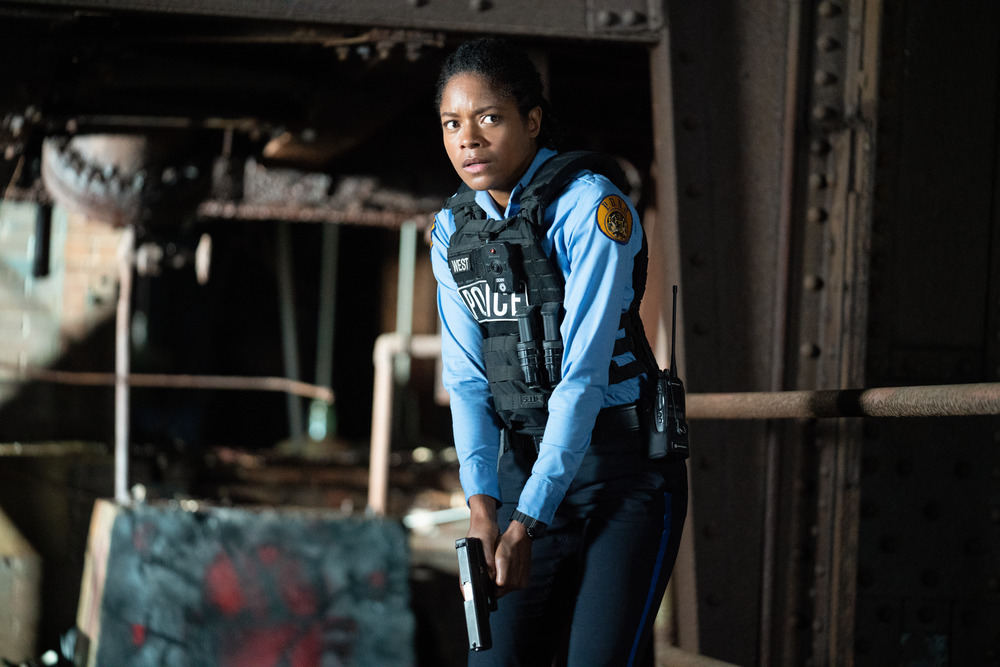
As West goes on the run, an all out manhunt begins, fueled by lies from the dirty cops as to what went down. In her old neighborhood, she knows the lay of the land and she knows the residents, but all refuse to help her because she’s now “blue.” That is, all but for one. Mouse. Yet, he’s not convinced of “the truth” West is telling him. Can West persuade anyone to believe her that there is no black and there is no blue. There is only the truth and what is right.
What is most appreciated about BLACK AND BLUE is not the black and white portrayal of divisiveness and the idea that if you’re a cop you turn your back on your community and if you’re a member of the community you don’t cooperate with the cops, or the idea that cops dismiss certain communities from protection and law enforcement. The most inspiring and uplifting message of BLACK AND BLUE is that it shows someone who has courage to cross the line and stand up for what is right and just and is the truth. Very powerful message that is cogently put forth.
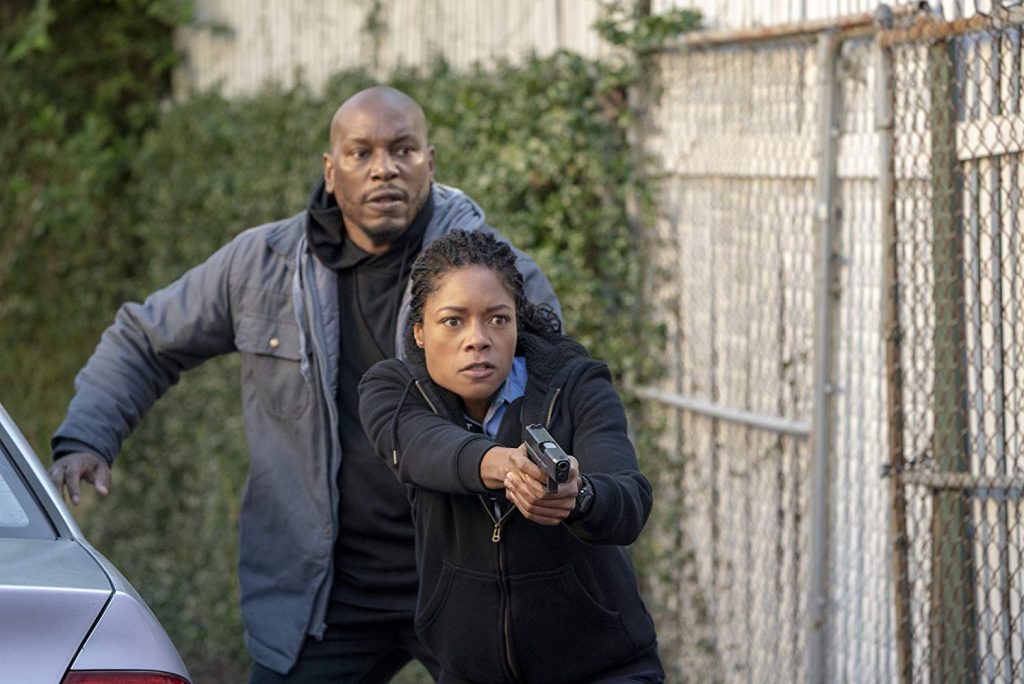
Timely and topical and mirroring what has been happening in society today, story structure is solid with the dynamic between West and Mouse being the key to the success of the story. Through them and the chemistry between Naomie Harris and Tyrese Gibson, the idea of mutual self-sacrifice and the building of trust between people through that sacrifice is displayed. Beautiful and powerful. Action is adrenaline fueled more by way of foot pursuits through the Ninth Ward as opposed to expected vehicle chases.
An intense, edge-of-your-seat thriller, BLACK AND BLUE thrives on the energetic and frenetic performances of Naomi Harris, Tyrese Gibson, and Frank Grillo. Harris is riveting as Officer Alicia West while Grillo solidifies himself as the most underrated bad guy in cinema as cop gone bad Terry Malone. As Malone, Grillo is evil personified. On the other hand, Tyrese Gibson delivers a beautiful and poignant performance as Milo “Mouse” Jackson. There is a tenderness and almost naive willingness to open his mind and heart that
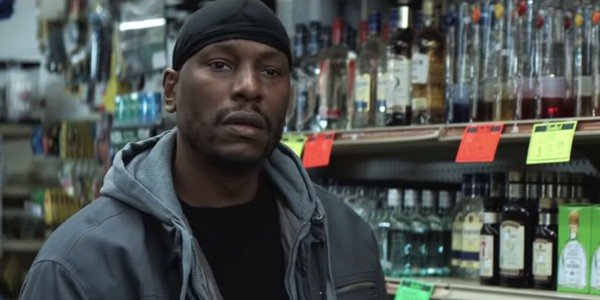
Another dynamic turn comes from Beau Knapp as Malone’s partner and accomplice Smitty. Knapp’s snark and “quick to shoot and kill” persona is chilling, and very effective at ratcheting up the tension during the course of the night. So convincing in the role, you just want to reach into the scream and smack Smitty upside his head the first moment he appears on screen. And then some nice icing on the casting cake is Reid Scott as West’s regular partner Kevin Jennings. Scott plays Jennings with tacit ambiguity that is both intriguing and ultimately telling.
Going beyond performance, BLACK AND BLUE rises and falls on Dante Spinotti’s cinematography and Peck Prior’s editing. A combination of the location and lensing allows us to feel the despair of the community, of the culture, and by extension, the reigning injustice and corruption. It becomes sensory and tangible within the tonal bandwidth of the film as a whole.

Rich, textured, and telling, the claustrophobic manhunt scenes within the Lower Ninth Ward post-Katrina projects are excruciatingly real. Lensing in real locations and not a set, the condition of key Kingston Manor apartments is not set-dressed. Narrow passages, stairwells, and interior doorways metaphorically speak to the walls closing in on both West and Malone. Tight framing and interesting camera angles intensify the tension and danger, making it palpable. Spinotti runs with camera in hand to provide immersive over-the-shoulder POV. Flooring and walls that we see on-screen is how the premises are off-screen. One key scene involving the local drug kingpin with trap doors and hidden walls is exactly how Spinotti and Taylor found the location and incorporated it into the story.
A driving force of the narrative is the use of extreme close-ups (ECU). Judiciously used and very effective as the 3/4 and ½ profiles provide introspective looks at our subjects. We see the wheels turning as West or Mouse are thinking through their next moves. Lensing of Jennings is key to his character arc. And the feral, raw, visceral, and calculating nature of Malone is perfectly captured when viewed thru the lens of Spinotti.

Stunning is a nighttime sequence in Kingston Manor depicting graffiti murals on all of the exterior walls. Done by local artists throughout NOLA following Katrina, each focuses on people, faces and eyes, metaphorically speaking to themes in BLACK AND BLUE that someone is always watching. It was the discovery of these murals that aided in the selection of the Kingston location for the film. And these murals pop with color and vibrancy giving a feeling of hope that contrasts the visual and emotional tone of the area, almost as if a bright shining light amidst the darkness of despair.
The entire film is awash in a denatured greyish-blue tint which plays to the weight of the moisture-filled bayou air and grey skies over the course of one day and night. Notable is that the camera captures that hanging mist in the air, particularly in the night exteriors.
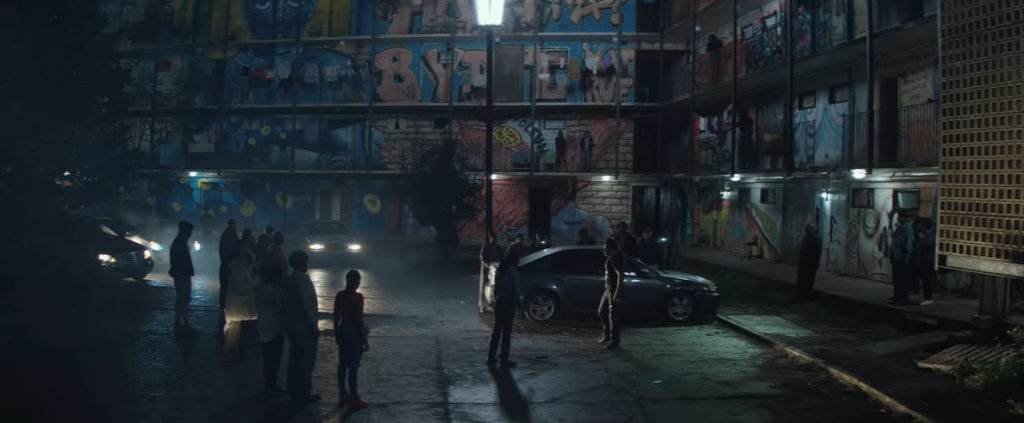
Always a must in a Deon Taylor film are opening aerial establishing shots. He doesn’t deviate from that set-up here as we get a lay of the land with patrol cars travelling across the roads. Where Taylor does differ from his prior films with this type of shot is that here the police vehicles are traveling in straight lines versus the twisty roads as in “The Intruder” and “Traffik”. Gives us the metaphoric idea of a police investigation being methodical, calculated, and plotted with directness.
Prior’s editing is tight and crisp. Pace is rapid-fire and fraught with tension which just intensifies as the film progresses thanks to an effective mix of mid-close-ups, ECUs and the integration of West’s bodycam footage and store surveillance video. As we physically see in Kingston Manor, eyes are everywhere.
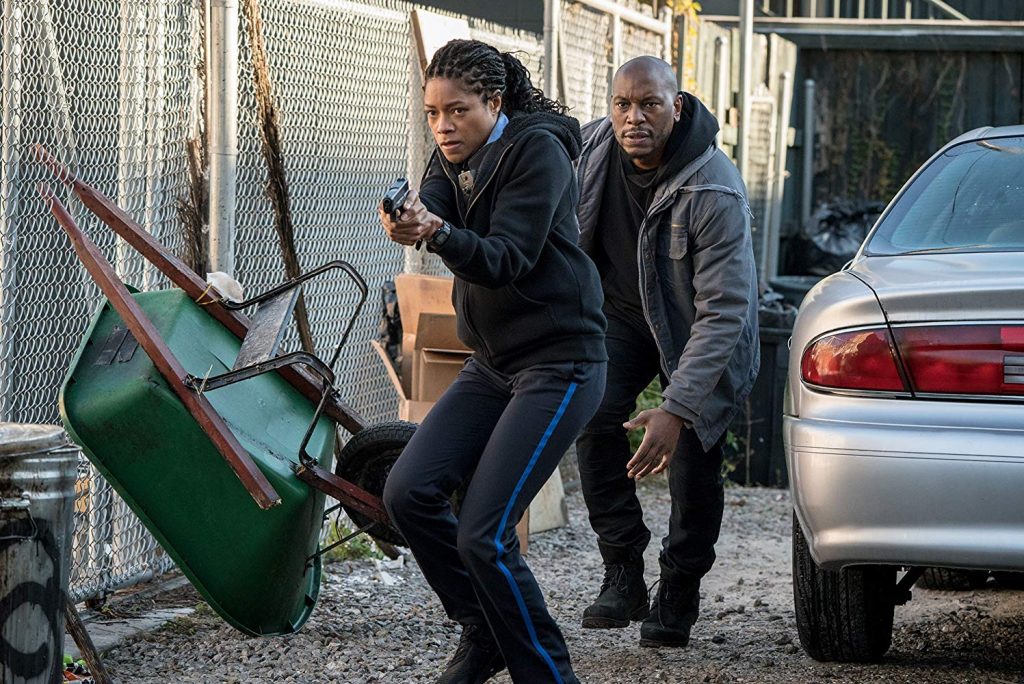
Geoff Zanelli reteams with Taylor providing a pulsating score punctuated by topical needledrop tracks.
Through solid storytelling and visually stimulating filmmaking, BLACK AND BLUE starts the conversation and encourages us all to be the change.
Directed by Deon Taylor
Written by Peter Dowling
Cast: Naomie Harris, Tyrese Gibson, Frank Grillo, Beau Knapp, Reid Scott
by debbie elias, 10/11/2019











